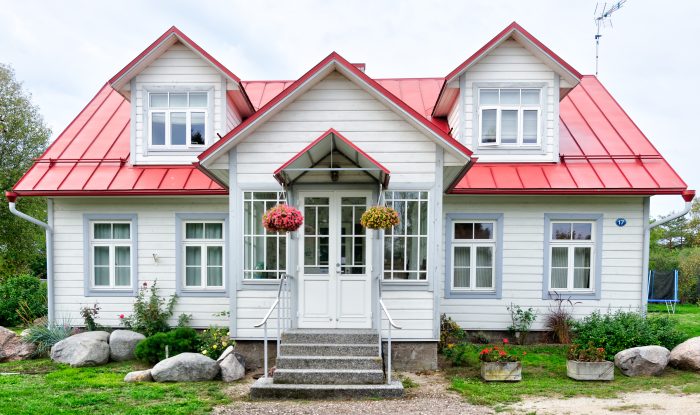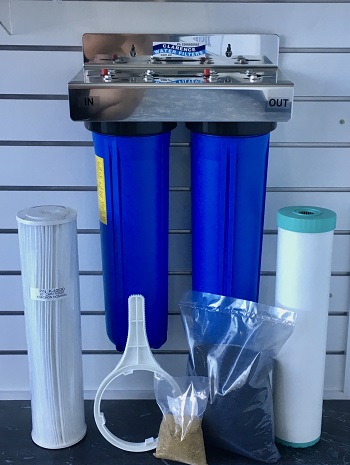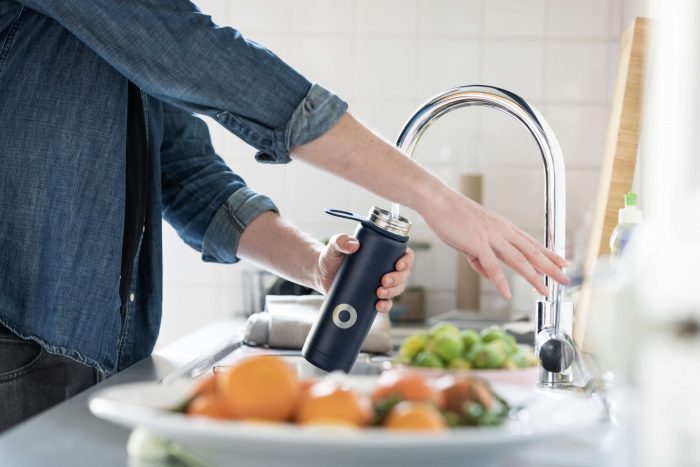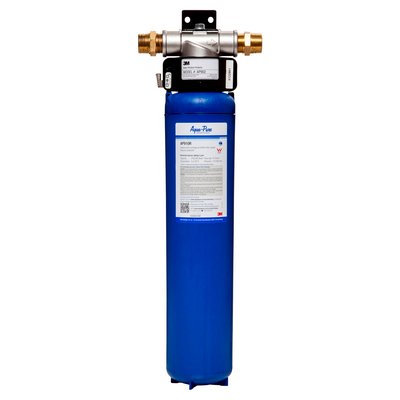
13 Benefits Of Installing A Whole House Water Filtration System
July 13, 2022 3:13 pm Leave your thoughts
Many Australians have become increasingly concerned about the quality of the water coming into their homes.
Although our water is reasonable by international standards, it can still contain sediment, dissolved solids, chlorine, and other chemicals. It’s not Not the most pleasant water to shower in or drink.
There are many options available for filtering water in your home. However, the most cost-effective option is to filter it at the point of entry using a whole house water filtration system.
Whole house water filters will filter 100% of the water coming into your home. This means all of the water going to your drinking water taps, showers, baths, washing machines, refrigerators, and hot water systems will be filtered.
In this post, we’ll take a closer look at whole house water filter systems and share the top 13 benefits of having a whole house water filter system installed.
If you have any questions give us a call on 0266468565 or send us an email.

Products Mentioned In This Guide
- Single 20” x 4.5” Big Blue Filter Housing With Sediment Filter
- Single 20” x 4.5” Big Blue With Carbon Filter (For low sediment town water)
- Twin 20” x 4.5” Town Water Supply Water Filter System (Disposable Filters)
- Twin 20” x 4.5” Town Water Supply Water Filter System (Reusable Filters)
- Twin 20” x 4.5” High Chlorine & Chloramine Twin Whole House Water Filter System With Catalytic Carbon, KDF
- 3M AP902 Whole House Filter For Sediment Removal
- 3M Aqua-pure AP904 Whole House Water Filter – Sediment, Chemical, and Scale Reduction
Contents
What Is A Whole House Water Filter?
Types of Whole House Water Filter Systems
Benefits Of Whole House Water Filter Systems
1. Removes Potentially Dangerous Chemicals From Your Tap Water
2. Makes You Better Looking!
3. Better Tasting Food
4. Showering Will Much More Enjoyable
5. Cleaner Clothes
6. Huge Cost Savings
7. Reduces Your Impact On The Environment
8. Better Quality of Life
9. Prolonged Appliance Life
10. Cleaner Water for Your Pets
11. Easy to Install and Maintain
12. A Cleaner Home
13. Softer Water
Frequently Asked Questions
How does a whole house water filter work?
Are there any disadvantages to using a Whole House Water Filter?
What Kind Of Whole House Water Filter Do I Need?

What Is a Whole House Water Filter?
Whole house water filters are large filtration systems designed to handle high flow rates over 20 litres per minute. They are typically installed where the water mains line enters a property, before any taps or water-consuming appliances. This means all of the water running through the property is filtered before it can be used.
Types of Whole House Water Filter Systems
The most common whole house water filter systems use “Big Blue” filter housings (pictured above). Each cannister houses a standard 20” x 4.5” water filter, which measures approximately 510mm x 115mm.
This type of system is often called a ‘drop-in filter cartridge system’, as the filters are dropped into re-usable housings.
The beauty of Big Blue systems is that you can use a wide variety of different filters in them. They can take many types of sediment filters, carbon block filters, and refillable filters with different types of media.
This flexibility makes it easier to find a combination of filters and filter media which addresses the contaminants you are most concerned about.
The other common form of whole house water filter uses a filter head onto which a fully self-contained filter cartridge is attached. The filter cartridge screws onto the filter head like a light bulb.
Once the filter cartridge has reached maximum capacity or its media has been depleted, the entire filter is discarded. The 3M™ AP900 is an example of this type of filter. 3M™ call this style of whole house filter a Sanitary Quick Change Cartridge System.
The advantage of this system is that you never have to touch the filter itself, which makes it more hygienic.
Benefits Of Whole House Water Filter Systems
1. Removes Potentially Dangerous Chemicals From Your Tap Water
There are dozens of chemicals in Australian tap water. Some of them are intentionally introduced in order to sanitise the water, like chlorine, while others are introduced by pollution or natural hydrological events.
Some of the most hazardous chemicals are actually a result of the disinfection process.
When chlorine interacts with decaying organic matter, it can create dozens of new chemicals disinfection by-products (DBPs). One of the most hazardous DBPs created by chlorine are Trihalomethanes — a group of reactive chemical compounds including dibromochloromethane, trichloromethane, and trifluoromethane.
Trihalomethanes have been linked to several health problems including cancer and reproductive issues.
Other chemicals which can find their way into our water supply include PFAs, pharmaceuticals, pesticides, insecticides, fertilisers, and petrochemicals. In many cases, the effect that these types of chemicals have on the human body is not fully understood.
Whole house water filter systems contain media which can remove many of these of these chemicals, like activated carbon, KDF, and catalytic carbon. This means less chemical exposure for you and your family.
2. Makes You Better Looking!
No, I’m not joking — installing a whole house water filter can actually improve your looks.
When you shower in town water, you are exposing yourself to a wide variety of chemicals, with the most abundant being chlorine.
Unfortunately, chlorine can have an extreme drying effect on your hair and skin as it breaks down the natural oils that your body produces. It can also damage proteins that make up hair strands. This can lead to frizzy hair and blotchy red skin.
If you have a skin condition like acne, dermatitis, or psoriasis, the negative impact of chlorinated water can be even more extreme, with severe flareups being much more common.
Once chlorine is removed from your water by a whole house filter, you may notice that your hair looks lustrous, your skin clears up and your overall appearance improves. It’s the simplest way possible to make yourself even more beautiful.
3. Better Tasting Food
Town water containing chemicals, sediment, poor taste/odour, and mineral imbalances can have a dramatic impact on the quality of your food.
Just think about it — whenever you use water to make a sauce or marinade, to cook pasta, to rinse your salad, you may be also adding unwanted contaminants. This can have an impact on the taste, odour, and texture of your food.
A whole house filter system removes the majority of contaminants in your water, leaving you with pure, fresh-tasting water. It can improve the quality of your food, helping you get more enjoyment from the food you prepare.
4. Showering Will Much More Enjoyable
Spending time in the shower also becomes more enjoyable with a whole house filter. The water will be slightly softer after running through a carbon filter and you won’t have to deal with the bad taste/odour of chlorinated water. The air you breath will be better as well, as there won’t be any aerosolised chemicals from the steam produced by the shower’s hot water.
5. Cleaner Clothes
Have you ever taken your clothes out of the washing machine and noticed spots or discolouration? It could be a result of sediment or chemical contaminants in the water supply.
Whole house filters can remove many of these contaminants, helping you enjoy clothes that are brighter and free of unwanted marks. It also reduces the risk of damage to your washing machine.

6. Huge Cost Savings
If you currently drink bottled water, you could save hundreds of dollars annually by purchasing a whole house filter system. In fact, the cost of installation could be a net saving if you are a heavy water drinker.
Whole house systems can also have lower maintenance costs compared to point-of-use systems like under-sink units and fridge filters. You can achieve more thorough filtration at a lower cost.
7. Reduces Your Impact On The Environment
Australians consume millions of bottles of water annually. Unfortunately, this results in a huge amount of plastic pollution as those bottle are often placed in landfill or make their way into the ocean.
A lot of fossil fuels are also used to make plastic bottles and transport bottled water to the destination where it is sold.
Having a whole house water filter system means you will no longer need to purchase bottled water. You can use glass bottle in your refrigerator and stainless steel flasks for when you are out and about. A wonderful way to reduce your environmental footprint.
8. Better Quality of Life
Water is an essential nutrient which we need for survival. It is used to maintain our organs, remove waste, facilitate growth, lubricate the eyes and many other important biological tasks.
Having high-quality pure water available means that your body will remain in top shape, which has a dramatic flow on effect on the quality of your life. When you drink high-quality filtered water, you may discover you have more energy, perform better at work and find exercising more enjoyable.
9. Prolonged Appliance Life
Reducing the amount of sediment and chemicals in your water even helps the mechanical members of the family. It will protect all of your water consuming appliances including dishwashers, refrigerators, and water heaters. A great way to prevent mechanical issues from occurring, which saves you even more money.
10. Cleaner Water for Your Pets
Pets also benefit from having cleaner water in their drinking bowls. They are more likely to drink water if they find it tastes delicious, which helps them live a long and happy life.
Having filtered water in your home also means your pets will be bathing in better quality water, which reduces the likelihood of skin irritations which cause them to scratch or bite at themselves.
11. Easy to Install and Maintain
Installing a whole house water filter is a simple task for any qualified plumber. In most cases, they will complete the installation in an hour or two.
Once installed, whole house systems are simple to maintain. There are no electronics or moving parts involved, which means there is much less risk of the system failing. Replacing filters is easy and there is very little risk of the system having trouble if correctly installed.
12. A Cleaner Home
By removing sediment particles from the water, less dirt, rust, sand, and silt will make their into your bathroom and kitchen. This means less staining of bath tubs, sinks, washing machines, and showers – so less cleaning around the home.
Whole house filters can also be used to soften the water coming into your home. Having softer water will make it easier for soap to dissolve and form a lather, which makes cleaning your home easier.
13. Softer Water
Whole house systems can use polyphosphate or resin to soften the water entering your home. Polyphosphate works by sequestering calcium ions so they can’t form scale, while resin swaps calcium/magnesium ions for other particles (known as ion exchange).
This is a wonderful option for homeowners living in parts of Australia with hard water, like Queensland, South Australia, and Western Australia. Softening your water will protect your home and water-consuming appliances from scale build-up.
Frequently Asked Questions
How does a whole house water filter work?
Most whole house systems will use several water filters to purify all the water coming into a premise. They can use a variety of filtration techniques to clean the water including:
Mechanical Filtration
The filter acts like a sieve, trapping particulate matter. Most filters with have sediment pads or a sediment wrap which uses mechanical filtration to stop particulate matter. Sediment filters are entirely made up of material designed to trap particulates.
Adsorption Filtration
As the water flows through the filter media, contaminants become stuck to its surface. This is how activated carbon works. It has uses billions of microscopic pores to trap chloramine, chloramines, pesticides, and other contaminants.
Sequestration filtration
Sequestration filtration involves ‘locking up’ contaminants by wrapping them in another substance. The most common media used for sequestration is polyphosphate. It wraps up calcium ions in the water, preventing them from forming scale – very useful for areas in Australia that have hard water.
Ion exchange
Ions are negatively or positively charged atoms or molecules. Certain types of media are capable of removing or adding electrons to change the form of these particles and by doing so removing contaminants.
One example is KDF, which is a blend of copper and zinc. As oxygenated water flows past, chlorine lose an electron to the copper, turning into chloride – a harmless electrolyte. Ion Exchange Resin is capable of exchanging contaminants for other harmless particles.
Are there any disadvantages to using a Whole House Water Filter?
There are pros and cons involved with every form of water filtration. However, there are very few when it comes to Whole Hoouse systems. They include:
- Initial Costs
The purchase price of a whole house filter can be anywhere from $300 to $1,000+. Unless you are a handyman, you’ll have to pay for a plumber for installation as well.
- Finding Available Space Around Your Home
Whole house water filter systems need to be installed somewhere between the mains water line and your home. You’ll need to find an area with enough space that isn’t exposed to harsh weather or excessive sunlight. This isn’t always easy if you have established plants or pathways around your home.
- Ongoing Maintenance Costs
All water filtration systems involve a certain amount of maintenance. You will have to spend money on filter and/or media replacements plus miscellaneous costs like o-rings.

What Kind Of Whole House Water Filter Do I Need?
The type of filter you need will vary based on the quality of your water, the contaminants you are concerned about and how much water you use.
You can give us a call on 0266 468 565 to discuss your situation or email us at sales@clarencewaterfilters.com.au.
Here is a quick guide on common contaminants and the types of systems which can address them:
Whole House Filter Finder |
|
Town or Tank Water If your only concern is sediment, the following options may be ideal: Single 20” x 4.5” Big Blue With Sediment Filter |
| Town Water Goal: Sediment, Chlorine, and Chemical Reduction For town water containing chlorine and other chemicals, an activated carbon filter should also be included in your filter system. It will adsorb a huge range of chemicals. The following systems would be ideal: Whole of House Taste Odour Filter for Low Sediment Town Water – Single Carbon Filter |
|
Town Water Chloramines are more difficult to remove than chlorine, due to their complex molecular structure. As a result, you will need to use catalytic carbon (KDF optional). The following systems would be ideal: High Chlorine & Chloramine Twin Whole House Water Filter System With Catalytic Carbon |
|
Town Water The simplest way to reduce scale is by adding polyphosphate as the last stage of a whole house system. If you are in an area with very hard water or heavy sediment water, a triple system might be useful (contact us for more information). High Chlorine & Chloramine Twin Whole House Water Filter System With Catalytic Carbon, KDF |
|
Tank Water If your tank water has a bad taste/odour or you are concerned about chemical overspray from nearby farms, using a twin system with carbon can be useful. The carbon in tank water systems is silver impregnated so bacteria cannot grow inside the filter cannister. Tank or Rural Water Twin Whole of House Filter System With Silver Impregnated Carbon |
|
Tank Water If you collect rain water and store it in a plastic tank, it can remain quite acidic. The solution to this issue is to install a calcite filter system. |
Whole House Water Filters are a great way to remove contaminants from all of the water entering a property. Installing a filter safeguards the health of your family and makes consuming water a much more enjoyable experience. If you would like to learn more, contact us today!
Clarence Water Filters Pty Ltd
Phone: 02 6646 8565
Email: sales@clarencewaterfilters.com.au
Tags: Benefits, Buyers Guide, Whole House Filters, Whole House FiltrationCategorised in: Buyer's Guides, Water Filtration, Whole House Water Filtration
This post was written by Paul

